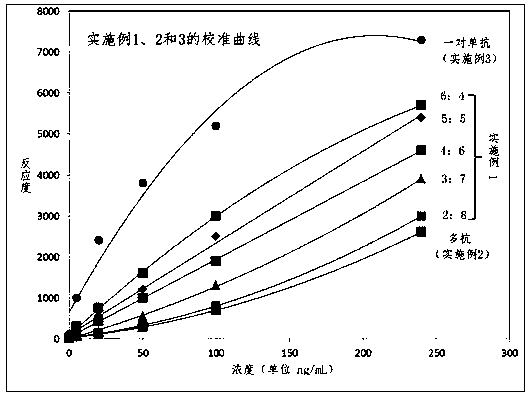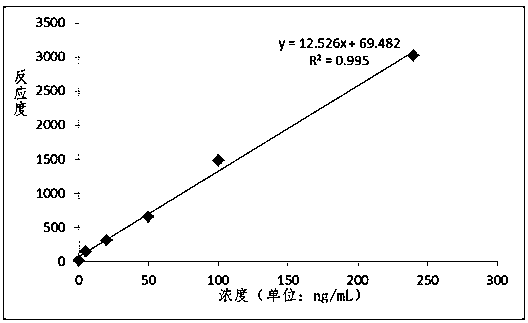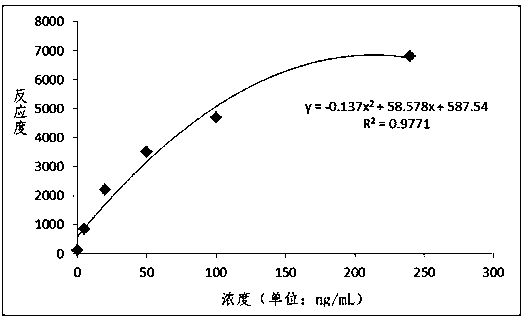Detection kit for heparin binding protein and preparation method thereof
A technology of heparin-binding protein and detection kit, which is applied in the detection field of heparin-binding protein, can solve the problems of detection reagent sensitivity, specificity, and unsatisfactory linear range, and achieves the effects of wide measurement linear range, simple operation and simple composition.
- Summary
- Abstract
- Description
- Claims
- Application Information
AI Technical Summary
Problems solved by technology
Method used
Image
Examples
Embodiment 1
[0045] 1) Preparation of latex reagent (333nm, reaction solution R2) labeled with combination of monoclonal antibody and polyclonal antibody
[0046] Polystyrene latex particles with carboxyl groups on the surface (classification number P0323, manufacturer JSR Life Sciences Corporation) with a particle size of 333 nm were labeled by the intermediate ester method. The surface carboxylated microparticles with a particle size of 333 nm were diluted to 1% in MES buffer solution and stirred at room temperature. Throw in EDC and Sulfo-NHS solid powder, centrifuge at 10000RPM for 20 minutes after stirring for 2 hours. The latex was washed twice with MES buffer solution, resuspended and divided into two parts. One part was added with HBP monoclonal antibody, stirred for 2 hours, and the other part was added with HBP polyclonal antibody, stirred for 2 hours. Both latexes were then centrifuged at 10,000 RPM for 20 minutes, and the supernatant was discarded. The two sets of precipitat...
Embodiment 2
[0056] 1) Preparation of polyantibody-labeled latex reagent (333nm, reaction solution R2)
[0057] Polystyrene latex particles with carboxyl groups on the surface (classification number P0323, manufacturer JSR Life Sciences Corporation) with a particle size of 333 nm were labeled by the intermediate ester method. The surface carboxylated microparticles with a particle size of 333 nm were diluted to 1% in MES buffer solution and stirred at room temperature. Throw in EDC and Sulfo-NHS solid powder, centrifuge at 10000RPM for 20 minutes after stirring for 2 hours. The latex was then centrifuged at 10,000 RPM for 10 minutes, and the supernatant was discarded. The precipitated latex was resuspended in the stock solution and ultrasonically dispersed, stirred for 1 hour before use. In this example, reaction solution R2 includes latex particles, buffer solution, salt, stabilizer, suspending agent and preservative, wherein the concentration of latex particles labeled with HBP antibod...
Embodiment 3
[0060] 1) Preparation of latex reagent (333nm, reaction solution R2) of a pair of monoclonal antibodies
[0061]Polystyrene latex particles with carboxyl groups on the surface (classification number P0323, manufacturer JSR Life Sciences Corporation) with a particle size of 333 nm were labeled by the intermediate ester method. The surface carboxylated microparticles with a particle size of 333 nm were diluted to 1% in MES buffer solution and stirred at room temperature. Throw in EDC and Sulfo-NHS solid powder, centrifuge at 10000RPM for 20 minutes after stirring for 2 hours. The latex was washed twice with MES buffer solution, resuspended and divided into two parts. Each of the HBP monoclonal antibodies was added, and the reaction was stirred for 2 hours. Both latexes were then centrifuged at 10,000 RPM for 20 minutes, and the supernatant was discarded. Both precipitated latexes were resuspended and sonicated in stock solution, and stirred separately for 1 hour. In this exa...
PUM
| Property | Measurement | Unit |
|---|---|---|
| Diameter | aaaaa | aaaaa |
| Particle size | aaaaa | aaaaa |
| Particle size | aaaaa | aaaaa |
Abstract
Description
Claims
Application Information
 Login to View More
Login to View More - Generate Ideas
- Intellectual Property
- Life Sciences
- Materials
- Tech Scout
- Unparalleled Data Quality
- Higher Quality Content
- 60% Fewer Hallucinations
Browse by: Latest US Patents, China's latest patents, Technical Efficacy Thesaurus, Application Domain, Technology Topic, Popular Technical Reports.
© 2025 PatSnap. All rights reserved.Legal|Privacy policy|Modern Slavery Act Transparency Statement|Sitemap|About US| Contact US: help@patsnap.com



